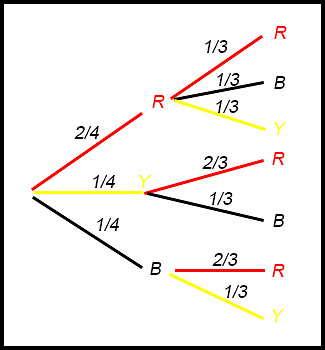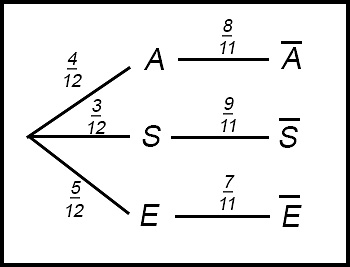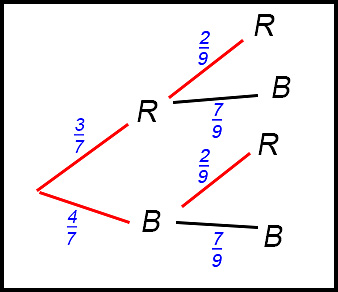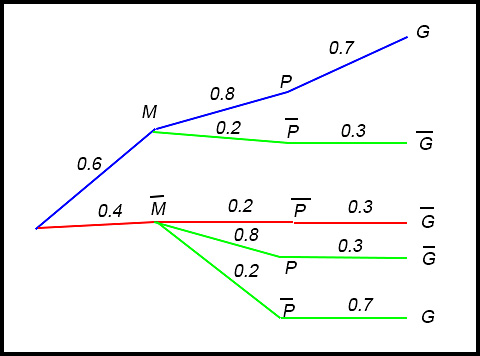Where the techniques of Maths
are explained in simple terms.
Probability - Probability trees.
Test Yourself 1 - Solutions.
- Algebra & Number
- Calculus
- Financial Maths
- Functions & Quadratics
- Geometry
- Measurement
- Networks & Graphs
- Probability & Statistics
- Trigonometry
- Maths & beyond
- Index
| Basic | 1. We could draw a tree but not essential in this question for the first 2 parts - up to you. Maybe safer if you are not sure. There are 5 English speakers in the 12 students. (i) both speak English.
(ii) neither speaks English; There are 7 students who do not speak English.
(iii) they do not speak the same language. Now we need a tree - but with a difference by combining groups.
The letter with the bar indicates "NOT THAT". So A with the bar conveys the meaning "not Arabic". So multiplying across and adding down at the RH side:
|
2. The other five numbers can appear so the probability of the 6 not appearing in any one roll is 5/6.
|
|
4. (i) Probability of 2 red balls (taking the top all red route)
(ii) Probability of at least 1 red ball - so add 1 red to 2 red. Start with finding about 1 red ball by following both the
Now add the path in part (i)
(iii) Probability of at most one red - so add 1 red to 0 red (BB):
|
|
| . | |
| Complementary events. | 6.
(i) passes all three tests?
(ii) passes exactly one of these tests? Check the green lines.
(iii) passes at least one of these tests?
|
| Constant probability. | 6. A biassed coin is such that the probability of getting a head is 5/8. The coin is tossed twice. Answer.(i) (a) Pr(HH) = 25/64 (ii) Pr(TT) = 9/64. (iii) Pr (HT) = 15/32. (iv) Pr( T) = 3/8. |
| 7. The chance of rain on any day during July is given as being 1 in 10. What is the chance (to 3 decimal places)of: Answer.(i) (a) Pr(RRR) = 0.001 (ii) Pr(RR RR RR) = 0.000 - there is a chance but highly unlikely.. (iii) Pr (RFRFR) = 0.001. (iv) Pr(FFFFF) = 0.590. |
|
| With replacement | 6.From an urn containing 4 red and 7 white valls, two balls are drawn in succession without replacement. Find:
Answer.(i) Pr(W) = 7/11 (ii) Pr(?W) = 7/11. (iii) Pr (WW) = 21/55. (iv) Pr( at least 1 W) = 49/55. |
| 7.
|
|
| 8. | |
| 9. | |
| 10. | |
| Without replacement | 11.From an urn containing 4 red and 7 white balls, two balls are drawn in succession with replacement. Find:
Answer.(i) Pr(W) = 7/11. (ii) Pr(?W) = 7/11. (iii) Pr (WW) = 49/121. (iv) Pr( at least 1 W) = 105/121. |
12. Grace buys 4 tickets in a raffle. There is a total of 100 tickets being sold. The prizes on offer are $40 for first prixe,, $30 for second prize and $20 for third prize. Find the probability that Grace: Answer.(i) Pr(wins $70) = 1/40425 (ii) Pr(wins $30) = 16/13475. (iii) Pr (wins a prize) = 941/8085. (iv) Pr( at least 1 W) = 49/55. |
|
13. There are six balls in an urn. They are numbered with the digits 1 to 6. The balls are drawn one at a time. What is the probability that: Answer.(i) Pr(3 is 1st ball) = 1/6 (ii) Pr(2 or 4) = 1/3. (iii) Pr (product = 12) = 2/15. |
|
14. NO = there are 7 black balls and 11 balls - so reduce each number and multiply.
Multiply: (ii) Selecting at least one green uses the above result but also the two ways to get only one green from Container 2.
|
|
15. (i) Prob (Black) = 3/5. (ii) As GGG is not possible, Prob (BBB) = (iii) |
|
| Complementary events | 16. James hitting a moving target with an arrow at least once is to exceed 80%? Probability of hitting the target more than once > 0.80 Let the probability of missing every time (which is 0.8n) = 0.2 ∴ Taking logs: n = log0.8 0.2 = 7.213. Now to be less than the 20% chance of missing every time, James needs to shoot at least 8 arrows (because we just solved for equaling the 20%). So 8 is the number of shots James must make to have his probability of hitting the target at least once greater than 80%. |
| Harder | A blue ball is selected from Bag A with a probability of 4/7. That outcome gives 3 blue balls and 3 red balls in Bag B. Hence the probability of picking a red ball with this composition is 1/2. A red ball is selected from Bag A with a probability of 3/7. That outcome gives 2 blue balls and 4 red balls in Bag B. Hence the probability of picking a red ball with this composition is 2/3. Adding these independent outcomes give the probability of a red as 4/7. |
| Incomplete trees. | 21. In a game of football, the probability that Damien will tackle an opposing player is 0.7. If Damien does not tackle that player, the probability than Nathan makes the tackle on the attacking player is 0.4.
Find the probability that an attacking player is tackled. Answer.Pr(tackle) = 0.82 |
| Conditional probability | 25. 
(i) What is the probability that both selected marbles are red?
(ii) Unfortunately one marble rolls away and everyone sees that it is black. What is the probability that the remaining hidden marble is red? First go to any path with red-black combination. There are two such paths. Multiplying the probabilities along these paths and adding, we get: (2/4×1/3) + (1/4×2/3) = 1/3 Now go to the paths where there is a black. There are four paths: Multiplying the probabilities along these paths and adding, we get: 2/4×1/3 + 1/4×1/3 + 1/4×2/3+1/4×1/3 = 1/2 Conditional probability asks "probability along paths with red" given "probability along paths with black"? Divide these two answers to obtain the probabilty of a red given a black has been seen. Probability = 2/3. Alternatively, if a red is known to have been drawn, there are now 2 reds and a yellow left. So probability of a red = 2/3. |
.












 .
.
 .
.